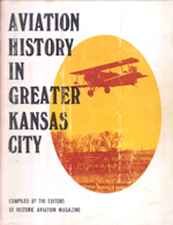|
Kansas City Times Kansas City, Missouri: September 21, 1912, Saturday Transcribed by Bob Davis - 6-17-04 Fatal to Russell G.Blair. Had Been in the Business Only a Month First Flight at Overland Park - Balky Engine Caused the Accident Blair was making his second flight of the afternoon - his contract called for but one. The engine of his Curtiss-Farman type biplane, which was built in Kansas City by J. C. McCallum and Frank W. Smith, was working poorly. He descended to a field to investigate the trouble. Soon he started back to the aviation park. His machine struck an air pocket and fell. The McCallum company discontinued operations finally and Blair became chauffeur for Ernest Jaccard of the Jaccard Jewelery Company, last summer McCallumand Smith rebuilt their machine, using a Smith 40-horsepower motor. Its speed was forty-five miles an hour. On August 27 Blair made two 18-mile flights at Overland Park and a dozen shorter ones. But his engine gave him much trouble and often burned out. A week ago he was saved from injury only by alighting in a corn field near the park. Blair and McCallum left for Shenandoah Wednesday night and expected to return Sunday. Information provided by: Sara J. Nyman, Special Collections Librarian, Missouri Valley Room Kansas City Public Library 14 W. 10th Street Kansas City, Missouri 64105 |
 |
AVIATION HISTORY IN GREATER KANSAS CITY Editors, Historic Aviation Magazine Product Details Softbound: 103 pages; 8 1/2" x 10 7/8" List Price: $55.00 Publisher: Cub Flyers Publications, Kansas City, ca. 1974 |
|
Description: "AVIATION HISTORY IN GREATER KANSAS CITY" was compiled by the editors of Historic Aviation Magazine, illustrated by photographs, sketches and 3-view drawings of the planes and flyers of the area. Kansas City's first aerial adventure occured in 1869 with a balloon ascension, and it hasn't stopped yet! Their International Balloon Race of 1911 is given coverage, then early flights by heavier than air craft, barnstorming,and finally aircraft construction. The local pilots are covered quite thoroughly, many of whom are still well known today in aviation circles. The staples have come loose from the cover of this used copy, and it shows some wear and soiling in a few places, but is still a sound and complete copy internally. A hard to find history of early aviation in the American Midwest. A used copy of this book was available from the Aviation Activities website. ( 1-6-05) You may access the site by clicking on: |
Three paragraphs extracted from AVIATION HISTORY IN GREATER KANSAS CITY by Bob Davis, 6-17-04 First tests of the craft, powered by a 70-hp engine, were made in secret in the middle of a large Kansas wheat field. When the biplane had demonstrated its ability to fly, it was moved to Overland Park, where the successful flights were made in August. Besides its tractor propeller arrangement, the McCallum aircraft differed from the Farman and Curtiss biplanes in that the entire wing could be tilted to change the angle of incidence in a turn. Ailerons were also incorporated in a manner similar to the Curtiss arrangement. It was reported that the tilting wing enabled the biplane to execute tighter turns with less roll, thereby producing a more stable and more maneuverable machine." |
|
If you have any more information on this Early Flier, please contact me. E-mail to Ralph Cooper Back 

|